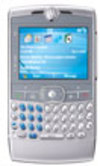While the Motorola Q phone got delayed in its release, I went out and got the new Cingular Blackberry 8700c a few months ago. Since then, my hands down favorite application has been Google Maps for my device. Call me cheap, but I have always hated using 411 service and getting charged exorbitant rates for getting a phone number. That is also why services like Free411 (one of Josh’s investments) have taken off so rapidly. As a stopgap measure, I used Google’s SMS service through my phone where I could easily send a SMS to 46645 and type in a zip code and directory query. The results came back quite quickly. I still use it for a quick stock quote or movie listing but lately I have migrated to Google Maps. As I mentioned in an earlier post, it is a great example of new phone applications that do not need carrier approval for distribution. To download it, all you need to do is go here with a javascript-enabled phone. The app itself if pretty small and easy to use-you type in a zipcode and query and you are quickly delivered an answer in either map or satellite view. You can zoom in, scroll around, get directions, and even initiate a phone call through the application. It also saves all of your previous queries. I can only imagine what this app will be like when you combine it with GPS and voice navigation. Sure, you can buy that through Verizon Wireless and Sprint but this is free! I am beginning to see more and more wireless plays that are trying to work around the walled gardens of the wireless carrier and this is one of the best I have seen thus far.
Category: Wireless
Wireless – bring down the walled gardens!
At the CIO dinner I was at last night (more on that later), I had the opportunity to play with a demo model of the Motorola Q Phone running on a Verizon EVDO network.  After a few minutes with this device, there is no doubt in my mind that Motorola will have another hit on its hand. It is as thin as the Razr, a little wider than my Blackberry 7100, has a full QWERTY keyboard, digital camera, full audio and video capabilities, and runs on Windows Mobile over Verizon’s high speed network. Trust me-this this device is worth waiting for when it comes out in Q1 2006.
After a few minutes with this device, there is no doubt in my mind that Motorola will have another hit on its hand. It is as thin as the Razr, a little wider than my Blackberry 7100, has a full QWERTY keyboard, digital camera, full audio and video capabilities, and runs on Windows Mobile over Verizon’s high speed network. Trust me-this this device is worth waiting for when it comes out in Q1 2006.
During my demo, one of the founders of a wireless application company showed me a financial trading application streaming with live after-market data. It really looked like any Bloomberg or Reuters 2000 terminal scrunched into a smaller form factor. I also used a variety of other applications which ran seamlessly on the Windows Mobile platform. This led us to a conversation on the "walled gardens" of wireless. Traditionally, consumers have had limited choice with respect to the software and services they are allowed to use on their device based on their wireless carrier. Sure, many carriers offered open web access on their phones but there really has been no point in browsing for information on the web with slow networks. In addition, browsing regular web pages through a small phone sucks. As wireless data networks like EVDO continue to increase their throughput (400-600kb), as devices like the Q get better and become more like mini-computers, the future will be leveraging the open web for downloadable mini-apps. One of the best examples of this is the Google Local for mobile application. Rather than go cut a deal with a carrier or launch its own MVNO (mobile virtual network operator), Google is playing the carrier-neutral angle allowing anyone with open web access from the phone to download the app. It is elegant, functional, and small but its usability is not limited to what a user can access through a browser. While this only runs on J2ME enabled devices, downloadable mini-apps will clearly be a trend that will continue in the future. Why do we need MVNO’s specialized and targeted to every slice of America when we should just be able to download and access what we want, when we want, and from any device. Let’s just hope that as we move into the future device manufacturers, carriers, and software vendors will get smart and find ways to create a truly open platform to break down the walled gardens of wireless, to allow end users to install any software from any vendor on any device, and thereby enable a wireless data explosion bringing lots of revenue to the carriers and lots of happy customers.